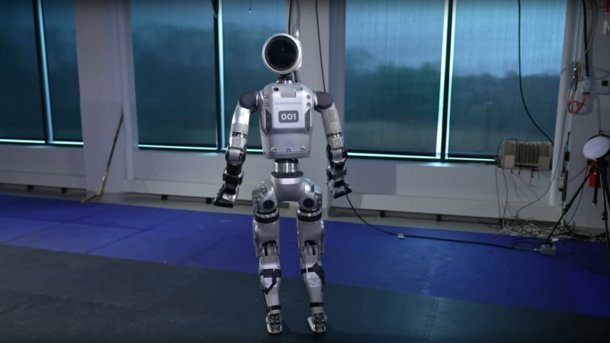Boston Dynamics unveils Atlas successor for commercial use
Atlas is no more, long live Atlas. Boston Dynamics has unveiled a new and improved successor to the original Atlas. It boasts significantly enhanced agility.

The new atlas has a wide range of movement. It can turn on the spot, for example. The photo shows how the head and upper body are pointing forwards, while the extremities are still pointing backwards.
(Bild: Boston Dynamics (Screenshot))
Just one day after Boston Dynamics discontinued its hydraulically powered humanoid robot Atlas, the robotics company unveiled its successor on Wednesday. The new, "electric" Atlas also features a whole range of improvements. First and foremost, there are electric motor drives that enable the robot to work more quietly. The developers have also equipped it with new AI and machine learning tools that enable it to perform tasks efficiently and adapt to complex work situations. This also marks the beginning of the commercial marketing of the humanoid robot, which could initially be used on a trial basis in car production at Hyundai, a subsidiary of Boston Dynamics.
The old Atlas still worked with hydraulic systems and was correspondingly fragile and loud. This is a knock-out criterion for its use as a robot that works together with humans. The new Atlas is therefore equipped with electric drives. They work quietly, react quickly, have a high torque and are more efficient than hydraulic systems.
Large range of motion
The electric Atlas is still designed as a humanoid robot. It has two arms and legs as well as a stylized head in which various sensors and cameras are housed to perceive the environment.
Boston Dynamics' approach is to make it perform movements as efficiently as possible. Accordingly, it has a high number of degrees of freedom that enable it to rotate its body and extremities by up to 360 degrees. This allows it to turn around on the spot, for example, and makes it more agile and maneuverable. Although it still resembles the human form, it can move more efficiently in work environments designed for humans, so it is not restricted by the human range of motion.
Boston Dynamics has not yet provided any precise details on the technical specifications of the Atlas robot. However, a video shows how it can move quickly and in a variety of ways with the new actuators.
Empfohlener redaktioneller Inhalt
Mit Ihrer Zustimmmung wird hier ein externes Video (Kaltura Inc.) geladen.
Ich bin damit einverstanden, dass mir externe Inhalte angezeigt werden. Damit können personenbezogene Daten an Drittplattformen (Kaltura Inc.) übermittelt werden. Mehr dazu in unserer Datenschutzerklärung.
New training methods
However, Boston Dynamics has not only redesigned the robot hardware from the ground up; the inside of the robot has also been overhauled and equipped with improved intelligence. It can now be trained using new AI and machine learning methods, such as reinforcement learning. Computer vision helps it to perceive its environment and adapt to complex real-life situations.
The Atlas robot can work together with the other two robots from Boston Dynamics, the robot dog Spot and the logistics robot Stretch. With the Orbit software, all three can be managed in robot fleets for industrial applications, for example, so that they can be integrated into companies.
Boston Dynamics is currently still testing various grippers for commercial use in order to be able to deploy it as flexibly as possible. Until then, it will probably first be used as a test at Hyundai in automotive production in order to gain experience with it in real work situations.
(olb)